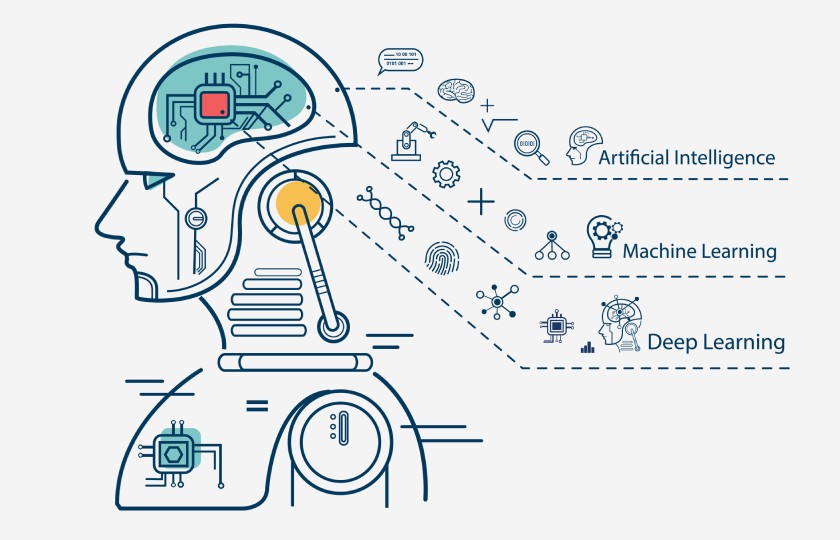Artificial Intelligence and Deep Learning: The Transformative Power of Technology
Introduction
At the forefront of modern technology, Artificial Intelligence (AI) and Deep Learning (DL) are reshaping industries and fundamentally altering the way we interact with machines. This article delves into the concepts of AI and deep learning, exploring their significance, applications, and the transformative potential they hold for the future.
What is Artificial Intelligence (AI)?
Artificial Intelligence, often referred to as AI, involves the development of machines, particularly computer systems, to simulate human intelligence processes. This encompasses tasks such as learning, reasoning, problem-solving, perception, and language understanding. AI aims to equip machines with the ability to mimic cognitive functions, enabling them to perform tasks traditionally requiring human intelligence. The field of AI is broad, encompassing various subfields, including machine learning, natural language processing, robotics, and computer vision, all of which contribute to creating intelligent systems capable of improving efficiency and solving complex problems across different industries.
Introduction to Deep Learning (DL)
Deep Learning, a subset of machine learning, has emerged as a powerful approach within the field of AI. DL algorithms are inspired by the structure and function of the human brain’s neural networks, hence the term “deep” referring to the multiple layers of interconnected nodes. These algorithms learn to perform tasks by processing vast amounts of data and identifying intricate patterns, without explicit programming. Unlike traditional machine learning algorithms that require feature extraction to be done manually, deep learning models can automatically discover the features needed for tasks such as image and speech recognition, making them highly effective in handling large, unstructured datasets.
The Significance of Deep Learning in Artificial Intelligence
Deep Learning has propelled the advancement of AI by enabling machines to achieve unprecedented levels of accuracy and performance in various tasks. From image and speech recognition to natural language processing and autonomous vehicles, DL algorithms have demonstrated remarkable capabilities. The ability to automatically learn representations of data through hierarchical layers of abstraction distinguishes deep learning from traditional machine learning approaches. This hierarchical learning process allows deep learning models to capture complex patterns and relationships in data, leading to breakthroughs in fields like computer vision, where deep learning algorithms now outperform humans in certain image classification tasks.

Applications of Artificial Intelligence and Deep Learning
The applications of AI and Deep Learning are diverse and widespread across numerous industries. In healthcare, AI-powered diagnostic systems aid in disease detection and medical imaging analysis. For instance, deep learning models are used to analyze radiology images, helping doctors to identify anomalies such as tumors more accurately and quickly than traditional methods. In finance, predictive analytics and algorithmic trading algorithms utilize DL for market forecasting and risk management, enabling more informed investment decisions and reducing the likelihood of financial crises. Moreover, AI-driven virtual assistants like Siri, Alexa, and Google Assistant use deep learning to understand and respond to voice commands, while recommendation systems on platforms like Netflix and Amazon enhance user experiences by providing personalized content suggestions based on individual preferences.
Challenges and Ethical Considerations
Despite the remarkable progress in AI and Deep Learning, several challenges and ethical considerations persist. Concerns regarding data privacy, algorithm bias, job displacement, and the ethical implications of autonomous systems necessitate careful consideration and regulation. For example, the use of biased training data can lead to AI systems that perpetuate discrimination, particularly in critical areas like hiring, law enforcement, and healthcare. Additionally, the automation of jobs through AI technologies raises concerns about economic inequality and workforce displacement, requiring policymakers and industry leaders to develop strategies that balance technological advancement with social responsibility. Moreover, ensuring transparency, accountability, and fairness in AI algorithms is paramount to fostering trust and societal acceptance, especially as AI systems increasingly influence decisions that impact people’s lives.
The Future of Artificial Intelligence and Deep Learning
As AI and Deep Learning continue to evolve, their impact on society is poised to expand exponentially. From advancements in healthcare, education, and transportation to innovations in robotics, augmented reality, and smart cities, the possibilities are limitless. For example, in healthcare, future AI systems could revolutionize personalized medicine, offering treatments tailored to an individual’s genetic makeup and lifestyle. In education, AI-driven adaptive learning platforms could provide customized learning experiences, helping students achieve their full potential. However, navigating the ethical, legal, and societal implications of these technologies will be crucial in shaping a future where AI serves as a force for good. The development of international standards and guidelines for AI ethics, coupled with ongoing public dialogue, will be essential to ensure that the benefits of AI and Deep Learning are shared equitably across society.
Conclusion
In conclusion, Artificial Intelligence and Deep Learning represent the vanguard of technological innovation, driving unprecedented progress and transformation across industries. As we harness the power of AI and DL to tackle complex challenges and unlock new frontiers, it is imperative to remain cognizant of the ethical considerations and societal implications inherent in these technologies. By fostering responsible development and deployment, we can harness the full potential of AI and Deep Learning to create a more equitable, efficient, and sustainable future. The continued collaboration between researchers, policymakers, and industry leaders will be key to ensuring that AI technologies are developed and used in ways that benefit all of humanity, paving the way for a brighter and more inclusive future.




